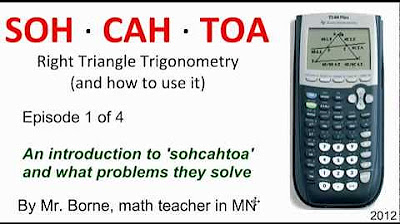When Do I use Sin, Cos or Tan?
Summary
TLDRThis educational video script explains the basics of trigonometry, focusing on when to use sine, cosine, and tangent functions with right triangles. It clarifies that knowing two sides or angles allows calculating the rest. The script introduces notation for right angles and unknown angles (theta), and explains the hypotenuse, opposite, and adjacent sides. It uses a 30-60-90 triangle example to illustrate sine, cosine, and tangent ratios. The presenter also shares a memory device, 'Sohcahtoa,' to remember the functions and encourages viewers to practice with provided links.
Takeaways
- 📐 **Trigonometry Functions**: The video explains when to use sine, cosine, and tangent in the context of right triangles.
- 🔗 **Right Triangle Basics**: Knowing two elements of a right triangle allows you to calculate the rest, including angles, area, perimeter, and side lengths.
- 📚 **Trigonometric Functions Defined**: Sine (sin), cosine (cos), and tangent (tan) are defined in relation to the sides of a right triangle and an angle (theta).
- 📏 **Hypotenuse and Angles**: The hypotenuse is the longest side and is opposite the right angle. The two acute angles in a right triangle always sum up to 90 degrees.
- 📐 **Standard 30-60-90 Triangle**: The video uses a 30-60-90 triangle to illustrate the ratios of sides in relation to the angles.
- 🔢 **Sine Calculation**: Sine of an angle is the ratio of the length of the opposite side to the hypotenuse.
- 📏 **Cosine and Adjacent Side**: Cosine of an angle is the ratio of the length of the adjacent side to the hypotenuse.
- 🔄 **Tangent Function**: Tangent of an angle is the ratio of the length of the opposite side to the adjacent side.
- 🔍 **Using Charts**: Trigonometric values for specific angles can be found on charts or calculated using a calculator.
- 📝 **Memory Aid**: The video suggests a memory aid ('sohcahtoa') to remember the functions: sine (opposite/hypotenuse), cosine (adjacent/hypotenuse), tangent (opposite/adjacent).
Q & A
What is the main focus of the short video?
-The main focus of the video is to teach when to use cosine, sine, or tangent in the context of right triangles, rather than how to use them.
What can you calculate if you know two things about a right triangle?
-If you know two things about a right triangle, you can calculate all the others, including angles, area, perimeter, and the length of the other sides.
What is the significance of the 'D' notation in a right triangle?
-The 'D' notation signifies a right angle, which is 90 degrees or 1/4 of a circle.
What does the Greek letter theta (θ) represent in a right triangle?
-Theta represents an unknown angle in a right triangle.
What are the three types of sides in a right triangle?
-The three types of sides in a right triangle are the hypotenuse (the longest side opposite the right angle), and the legs (the other two sides, sometimes referred to as the opposite and adjacent sides).
What is the hypotenuse in a right triangle?
-The hypotenuse is the longest side of a right triangle, which is always opposite the right angle.
What is the sine function in the context of a right triangle?
-The sine function is defined as the ratio of the length of the side opposite the angle (theta) to the length of the hypotenuse.
How is the cosine function different from the sine function?
-The cosine function is the ratio of the length of the adjacent side to the length of the hypotenuse, whereas the sine function is the ratio of the opposite side to the hypotenuse.
What does the tangent function represent?
-The tangent function represents the ratio of the length of the opposite side to the length of the adjacent side for a given angle in a right triangle.
What is the memory device 'sohcahtoa' used for?
-The memory device 'sohcahtoa' is used to remember the ratios of the trigonometric functions: sine (opposite/hypotenuse), cosine (adjacent/hypotenuse), and tangent (opposite/adjacent).
How can you verify the correctness of a calculated hypotenuse length?
-You can verify the correctness of a calculated hypotenuse length by checking if it is longer than the other sides of the triangle, as the hypotenuse is always the longest side in a right triangle.
Outlines

此内容仅限付费用户访问。 请升级后访问。
立即升级Mindmap

此内容仅限付费用户访问。 请升级后访问。
立即升级Keywords

此内容仅限付费用户访问。 请升级后访问。
立即升级Highlights

此内容仅限付费用户访问。 请升级后访问。
立即升级Transcripts

此内容仅限付费用户访问。 请升级后访问。
立即升级浏览更多相关视频

Vektor Fisika • Part 1: Pengantar Trigonometri Dasar

TRIGONOMETRI - Ukuran Sudut dan Perbandingan Trigonometri

Matematika SMA - Trigonometri (1) - Pengenalan Trigonometri, Perbandingan Trigonometri (A)

Basic trigonometry II | Basic trigonometry | Trigonometry | Khan Academy

SOHCAHTOA using the TI-84 Plus

Trigonometric Functions: Sine, Cosine, Tangent, Cosecant, Secant, and Cotangent
5.0 / 5 (0 votes)
